
Belemnoids are an extinct group of marine cephalopod, very similar in many ways to the modern squid. Like them, the belemnoids possessed an ink sac, but, unlike the squid, they possessed ten arms of roughly equal length, and no tentacles. The name "belemnoid" comes from the Greek word βέλεμνον, belemnon meaning "a dart or arrow" and the Greek word είδος, eidos meaning "form".

Moeritherium is an extinct genus of primitive proboscideans. These prehistoric mammals are related to the elephant and, more distantly, sea cows and hyraxes. They lived during the Eocene epoch.

An orthocone is the long, cone-shaped shell belonging to several species of ancient nautiloid cephalopod—the prehistoric ancestors of today's marine cephalopod mollusks, including the cuttlefishes, nautili, octopi and squids. During the 18th and 19th centuries, all such shells discovered were given the "catch-all" name Orthoceras, thus creating a wastebasket taxon. However, it is now known that many species, genera and families of nautiloids developed or retained this form of shell.

Orthocerida, also known as the Michelinocerida, is an order of extinct orthoceratoid cephalopods that lived from the Early Ordovician possibly to the Late Triassic. A fossil found in the Caucasus suggests they may even have survived until the Early Cretaceous, and the Eocene fossil Antarcticeras is sometimes considered a descendant of the orthocerids although this is disputed. They were most common however from the Ordovician to the Devonian.

Pycnodus is an extinct genus of ray-finned fish from the Eocene period. It is wastebasket taxon, although many fossils from Jurassic or Cretaceous are assigned to this genus, only Eocene species, P. apodus is valid. As its name suggests, it is the type genus of Pycnodontiformes.

Limnofregata is an extinct genus of primitive frigatebird. The two known species were described after fossils from the Early Eocene Green River Formation of Wyoming. A number of good complete and partial skeletons, some with feather impressions, are known of the type species, Limnofregata azygosternon, and L. hasegawai is known from two skulls and most of one torso.

Icaronycteris is an extinct genus of microchiropteran (echolocating) bat that lived in the early Eocene, approximately 52.2 million years ago, making it the earliest bat genus known from complete skeletons, and the earliest known bat from North America. Multiple exceptionally preserved specimens, among the best preserved bat fossils, are known from the Green River Formation of North America. The best known species is I. index. Fragmentary material from France has also been tentatively placed within Icaronycteris as the second species I. menui. I. sigei is based on well-preserved fragments of dentaries and lower teeth found in Western India. In 2023, the species I. gunnelli also from the Green River Formation was distinguished from I. index, and I. menui and I. sigei were proposed to be removed from the genus due to them not being closely related.

Notostylops is a genus of extinct South American ungulates from Eocene Argentina. Fossils of the genus have been found in the Sarmiento, Casamayor, Andesitas Huancache and Koluel Kaike Formations.

The common cuttlefish or European common cuttlefish is one of the largest and best-known cuttlefish species. They are a migratory species that spend the summer and spring inshore for spawning and then move to depths of 100–200 metres (330–660 ft) during autumn and winter. They grow to 49 centimetres (19 in) in mantle length and 4 kilograms (8.8 lb) in weight. Animals from subtropical seas are smaller and rarely exceed 30 centimetres (12 in) in mantle length.

Belemnitella is a genus of belemnite from the Late Cretaceous of Europe and North America. Belemnitella was a squidlike animal, probably related to the ancestors of modern squids and cuttlefish. The shell was internal. The rostrum or guard is found the most often and possesses a distinctive slit at its ventral surface and a ridge on the dorsal surface. The phragmocone has a small protoconch at its tip, and fit into the cavity and the guard. It also had septa and a ventral siphuncle within the phragmocone, projecting forward as a beak-like blade.

Cuttlefish, or cuttles, are marine molluscs of the order Sepiida. They belong to the class Cephalopoda which also includes squid, octopuses, and nautiluses. Cuttlefish have a unique internal shell, the cuttlebone, which is used for control of buoyancy.
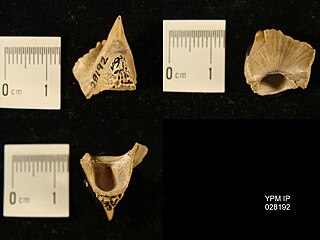
Belosaepiidae is an extinct family of cephalopods known from the Eocene epoch, and bearing close similarity to the sepiid cuttlefish, whilst retaining the remnants of a belemnite-like guard. It is thought that this species was most common for its time.

Duerosuchus is an extinct genus of crocodilian. Remains have been found from Corrales del Vino in Zamora, Spain, and are middle Eocene in age. Duerosuchus is known from a single skull that is incomplete but otherwise well preserved, as well as a lower jaw, some osteoderms, and possibly some vertebrae.
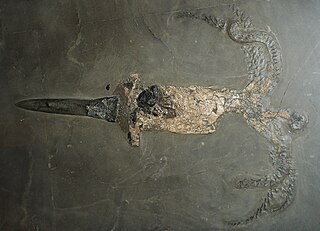
Belemnitida is an extinct order of squid-like cephalopods that existed from the Late Triassic to Late Cretaceous. Unlike squid, belemnites had an internal skeleton that made up the cone. The parts are, from the arms-most to the tip: the tongue-shaped pro-ostracum, the conical phragmocone, and the pointy guard. The calcitic guard is the most common belemnite remain. Belemnites, in life, are thought to have had 10 hooked arms and a pair of fins on the guard. The chitinous hooks were usually no bigger than 5 mm (0.20 in), though a belemnite could have had between 100 and 800 hooks in total, using them to stab and hold onto prey.
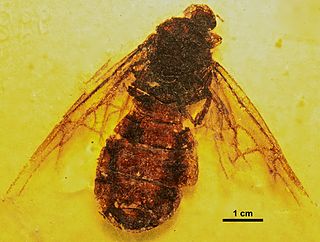
Titanomyrma is a genus of extinct giant ants which lived during the Eocene. The type species Titanomyrma gigantea and the smaller Titanomyrma simillima are known from the Eocene of Germany, while the third species Titanomyrma lubei, is known from Wyoming, United States. The presence of Titanomyrma in North America was considered to indicate "the first reported cross-Arctic dispersal by a thermophilic insect group".. However a queen reported from Upland temperate shales in British Columbia raised questions on the exact thermophilic nature of the genus. The type species of this genus, T. gigantea, is the largest-known fossil or extant species of ant in the world.

Asterotrygon is an extinct genus of stingray from the Eocene Green River Formation in Wyoming. Several complete skeletons representing juveniles, adults, males and females have been uncovered from the late early Eocene Fossil Butte Member of the formation. The type and only species, A. maloneyi, was named in 2004 on the basis of these fossils. Another stingray, Heliobatis, is also known from the formation. Asterotrygon is a primitive stingray closely related to the living family Urolophidae whose ancestors likely originated in the Indo-Pacific. It lived in Fossil Lake, a body of water that existed in a subtropical mountainous region for only about 2 million years.
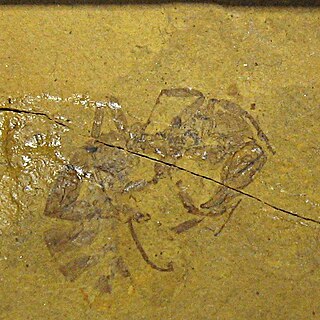
Myrmeciites is an extinct form genus of bulldog ants in the subfamily Myrmeciinae of the family Formicidae, which contains three described species and two fossils not placed beyond the genus level. Described in 2006 from Ypresian stage deposits, all three of the described species and one unplaced fossil are from British Columbia, Canada, while the second unplaced fossil is from Washington State, USA. These ants were large, with the largest specimens collected reaching 3 centimetres (1.2 in). The behaviour of these ants would have been similar to extant Myrmeciinae ants, such as solitary foraging, nesting either in the soil or trees, and leaving no pheromone trail to food sources. Due to the poor preservation of these ants, their phylogenetic position among Myrmeciinae is unclear, and no type species has been designated. These ants are classified as incertae sedis in Myrmeciinae, but some writers have classified it as incertae sedis within the insect order Hymenoptera. This reclassification, however, has not been accepted; instead, Myrmeciites remains in Myrmeciinae.
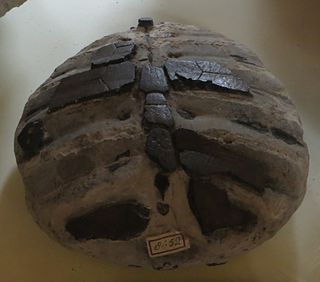
Puppigerus is an extinct genus of sea turtle from the Eocene. It is known from finds in the United States, the United Kingdom, Belgium, Denmark, and Uzbekistan.

Buxolestes is an extinct genus of semi-aquatic, non-placental eutherian mammals belonging to the family Pantolestidae. Species in this genus were part of the first placental evolutionary radiation during the Middle Eocene and found in the Bracklesham Group and Wittering Formation of England, at the Messel Pit in Germany and in Bouxwiller, France.

Drazinderetes is a large bodied genus of soft shell turtle from the Middle Eocene Drazinda Formation of Pakistan. Its presence in the shallow marine deposits of the Drazinda Formation suggests that Drazinderetes may have been a partially or fully marine animal. Indetermined trionychine remains from the same formation may suggest that Drazinderetes could have been among the largest known turtles, with one entoplastron indicating a potential length of 1.5 to 2.1 meters. Drazinderetes currently consists of only a single species: Drazinderetes tethyensis.





















